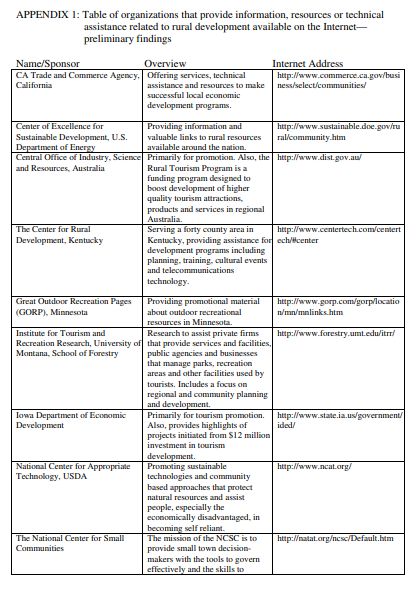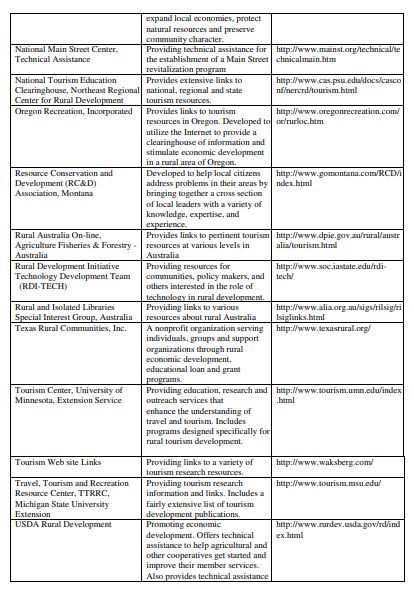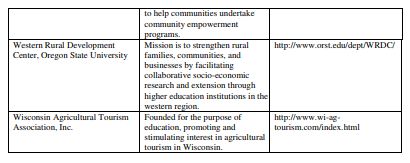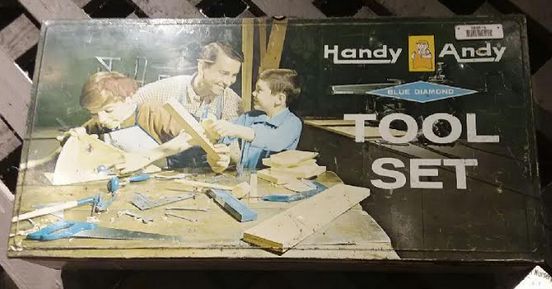
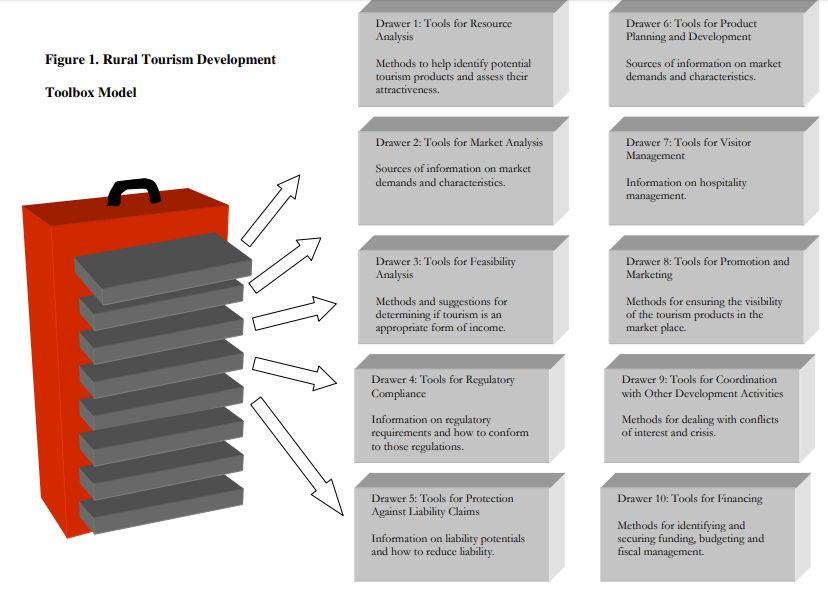
By:
Andrew N. Skadberg
Texas A&M
University
Dr. James R. Kimmel
Southwest Texas State
University
1999
Introduction
Tourism offers potentials for economic diversification in rural areas as urban residents seek alternative forms of recreation. Because open space, watchable wildlife, and rural communities are the actual attractions, tourism also offers the potential to stimulate conservation and community development in rural areas. However, most rural communities and families have little experience in the complex and competitive tourism industry. The potential benefits of tourism will be diminished if rural and small community residents do not have access to technical assistance programs to help them learn the essential skills of tourism development and management.
Although numerous agencies and universities offer such information (Appendix 1), the effectiveness of the information is reduced because people in rural areas are often not aware of its availability and do no know which approaches to tourism development may be most effective for their own situation. The purpose of the proposed program is to provide access to information about the various ways to develop rural tourism. Access will be provided in two ways. We will develop an Internet site that will identify, review, and evaluate methods to develop rural tourism. We will provide links from the Internet site to all relevant sources of information and useful examples of rural tourism attractions. We will also publish this information in hardcopy form for people who do not have access to the Internet. We will evaluate the use of these materials and revise them to correct problems if they arise.
Purpose
The purpose of this project is to develop, implement, and evaluate an Internet-based “Rural Tourism Development Toolbox” that will assist individuals, outfitters, rural communities, and regional organizations to gain access to information about planning, developing, and implementing tourism programs. This project will enhance existing programs by consolidating, evaluating and organizing these resources. The program will not be limited by personnel and travel constraints, and will be made available to a number of audiences interested in tourism development. The program will provide ongoing guidance about tourism development resources that are available and will provide linkages to successful tourism Internet sites that can serve as examples and provide motivation. The program will also establish networks between participants so that they can share information or services.
This program intends to develop simple ways to provide access for four target audiences to appropriate and beneficial tourism development resources. This approach aims to create an effective way to make regions, communities, individuals and families, and outfitters/guides aware of information and resources that are currently available for tourism development.
Following is an outline of the overall goals and specific objectives of this program. The Rural Tourism Development Toolbox will be designed to serve the needs of four potential user groups:
· Individuals and families (including landowners)
· Communities
· Outfitters and guides
· Regional organizations
Goals
· To provide usable, practical information to stimulate and guide development of appropriate nature and heritage tourism attractions in rural areas.
· To distill the mass of tourism development information and present it in a simple common-sense and motivating approach.
· To make this information easily available to those who can benefit from its use.
· To develop a dynamic process that can be evaluated for effectiveness and modified as needed.
Objectives
· Develop an Internet based tourism development program to provide necessary information and interact with its users.
· Develop a hardcopy version of the information.
· Identify appropriate and useful tourism development information.
· Organize and consolidate information and resources into functional units.
· Identify information and resources to assist each of the designated audiences.
· Pilot test, evaluate, and revise organization and information.
· Implement the overall program.
· Evaluate the overall program.
Current Status of Research
Tourism is one of the largest economic activities in the world (Jefferson 1995). Tourism based on natural resources is one of the most important and fast-growing sectors of the tourism industry (Erramouspe 1996). Tourism has the potential to increase conservation efforts on private lands because it provides an economic incentive to maintain and enhance habitats for watchable wildlife (Pigram and Wahab 1998). In recent years several authors have addressed issues in rural tourism, including economic feasibility, marketing, environmental and sociocultural impacts, and potentials for sustainability (Campbell 1999, Teo and Yeoh 1997, Var 1997; Dann 1997; Bramwell and Lane 1994; Emerick and Emerick 1994; Gannon 1994; Lane 1994; Crotts and Holland 1993; Lanier and Berman 1993; Pigram 1993; Evans and Ilbery 1992; Bryan 1991; Dernoi 1991; Warnick and Klar 1991; Pearce 1990; Maude and van Rest 1985). However, Opperman (1995:63) observed that “...rural and farm tourism still lacks a comprehensive body of knowledge and a theoretical framework.”
Few data exist on rural private-sector tourism, so it has not been a major focus of research. Existing businesses are small and widely scattered and are not usually included in official tourism enumerations. Bryan (1991:82) succinctly summarizes much of the current research on rural private-sector nature tourism:
Farm and ranch recreation can provide economic, educational, and environmental benefits: however, it is not a quick economic fix and can dash just as many hopes and dreams in implementation as it creates in concept. Nevertheless, it is an exciting new trend that can contribute to the sustainable development of rural communities, and offset pressure toward less environmentally sensitive alternatives such as agribusiness.
However, research on the planning, development, and management of tourism activities (products) has not received the attention it needs. Smith (1994: 583) noted:
Although few, if any, marketing professionals would challenge the importance of product development, the subject receives much less attention from marketing analysts, planners, and policymakers than do segmentation, consumer behavior, advertising, and promotional strategies.
The focus of this project is to provide assistance in developing appropriate tourism products (habitat, watchable wildlife, historic sites, and heritage activities). Tourists surveyed in 1992-93 ranked scenery as the most enjoyable aspect of their trip (Sharp 1993). A more recent survey also showed high demand for scenic drives, watchable wildlife, and access to rivers (Texas Department of Transportation 1996). In much of the United States almost all scenery, scenic drives, watchable wildlife, and access to rivers is on privately owned farm, ranch, and forest land. Thus, landowners have an outstanding opportunity to meet the demand for outdoor activities. While meeting these market demands, tourism can establish economic value for environmental features that otherwise may not be properly valued. People are willing to pay well to watch and photograph wildlife and to have restricted access to high quality natural areas (Kimmel 1997a).
The demand for rural-based tourism is likely to increase dramatically in the United States. The U.S. is an urban nation, and most of its population growth will be in its metropolitan regions. These future residents will demand outdoor recreation activities. Farmers, ranchers, and rural communities can meet this demand in a way not possible by any other element of the society. Outdoor leisure has traditionally been provided by state and national parks. However, the amount of land acquisitions for parks cannot keep up with population growth in many parts of the U.S. In addition, many visitors are interested in rural life itself. A recent Conde Nast Traveler survey showed that almost 90 percent of the magazine’s readers are interested in learning about the culture and lifestyle of the people in the areas they visit and 46 percent would like to live that lifestyle while they are visiting (Conde Nast Traveler Extra, September, 1998). Thus, tourists can be attracted by the authenticity of rural life.
In spite of the clear opportunities to meet the demand for tourism, many landowners do not recognize those opportunities or they are reluctant to pursue them. Kimmel (1997b) documented the concerns of landowners regarding what they viewed as the potential for tourism to result in governmental control of their land. A recent landowner workshop in Kerrville, Texas, identified specific concerns and information needs related to nature tourism development. Nineteen landowners and two outfitters spent two days in a process guided by Texas A &M University and assisted by the Texas Agricultural Extension Service, the Texas Nature Tourism Association, Southwest Texas State University, the Texas Department of Economic Development, and the Texas Parks and Wildlife Department. Participants in the workshop identified the following six areas where they need information (in order of priority): marketing, liability, operations, education and information, attitudes and psychology. In the final session of the workshop, the participants strongly expressed that they need practical information that is directly useful (Watt 1998).
The purpose of the Tourism Toolbox program is to provide access to information and resources that are fundamental to tourism development. Figure 1 illustrates the overall organization of the Rural Tourism Development Tourism Toolbox. There are two major components to the Tourism Toolbox 1) resource linkages, and 2) resource and program evaluations. The resource linkages will create a functional organization of tourism development resources. Many of the tourism resources available on the Internet provide links to other resources; however, few are user-oriented, or designed to assist regions, communities, landowners and outfitters/guides to create tourism development programs.
The Rural Tourism Development Toolbox will consist of a set of “functional drawers.” Each drawer will provide information and resource linkages about a particular topic/issue associated with tourism development. See Figure 1 for a set of preliminary topics. More functional topics may evolve from the tourism resources evaluation phase of the project.
In each drawer will be “tools” which will be resources or programs that are available from the various agencies or institutions. The second feature of the Tourism Toolbox is an evaluation of the resources that are provided. In other words a concise “owner’s manual” will be provided that overviews important information and an objective evaluation of the tools’ (programs and resources) strengths and weaknesses.
Preliminary, evaluation criteria for the “tools” include time required, cost (if there are any costs associated with the process), other inputs, expertise necessary (are there any special skills needed), and what audiences would this tool be effective for (regions, communities, individuals/families, outfitters/guides). Additional criteria will emerge from the review process. Some of the programs lead the user through an entire tourism planning process. However, the toolbox will allow users to mix and match resources from various programs. The Tourism Toolbox will promote both methods. Examples of the types of programs we will review and include in the tourism toolbox are: Rural Tourism Development from the University of Minnesota (Koth et al. 1991), Community Tourism Assessment Handbook, from the Western Rural Development Center, Utah State University (Brass 1997), Developing Tourism in Your Community from Texas A&M and the Texas Department of Economic Development (Richardson et al. 1995), and extension publications available from the University of Michigan.

Research Methods
Methods focus
on I) program development, and II) program evaluations.
I. Program Development
To develop the program we will identify, consolidate, organize, and present appropriate materials in a way that assists users to find and use the right tools for tourism development.
The tasks required to develop the program are as follows:
Task 1) Review and evaluate all technical assistance included in Appendix 1 and others that are found.
a) Determine the functional links between the “Drawers” of the toolbox and the appropriate sections of the various technical assistance programs to identify the various tools to be included.
b) Organize and consolidate information for “ease of use” and, where necessary, make arrangements for cooperative agreements with other agencies and institutions.
Task 2) Design formats for review of tools (tourism resources and information).
Task 3) Write tool reviews.
Task 4) Identify examples and links to identified web sites. We will identify Internet sites that serve as good examples of rural tourism development. We will summarize these sites and provide linkages to them.
Task 5) Set up the Internet mechanism for on-line discussions and information exchange. We will provide and manage on-line discussion groups that will facilitate interactions among people interested in rural tourism development.
Task 6) Develop the “Toolbox”
a) Determine appropriate web site and graphic design for disseminating information
b) Design the web site and test functionality
c) Design hard copy version
Task 7) Promote use of the Toolbox
a) Collect mailing and e-mail lists of “target audiences”. This project will be promoted nationally. In order to leverage our efforts and resources we will target Chambers of Commerce, Convention and Visitors Bureaus, and regional and other rural tourism development organizations that can disseminate information about the Tourism Toolbox to their constituents. In addition, we will identify state and federal agencies that are involved in tourism development.
b) Develop promotional plan—post cards, e-mail, Internet search engines
Task 8) Pilot-test the web-based Tourism Toolbox on a sub-set of identified audiences
a) Evaluate pilot-test
b) Re-design web site and toolbox organization as necessary
Task 9) Fully implement web site and publish hardcopy of toolbox and promote them.
Methods to evaluate the web site will include time on site, depth into site, an on-line user questionnaire, and response cards from users of the hardcopy version. Tasks to evaluate the program are as follows:
Task 1) Design evaluation instruments
a) survey (web and hardcopy)
b) time on site (web)
c) depth in-site (web)
d) on-the-ground evaluations (web and hardcopy)
Task 2) Formal evaluation of Rural Tourism Development Toolbox
a) Collect and analyze survey data
b) Conduct on-the-ground evaluation of users of the toolbox
Task 3) Maintain e-mail and telephone contact with users of the Tourism Toolbox for an ongoing evaluation of the Tourism Toolbox.
Task 4) Evaluate descriptions of tourism activities actually developed as a result of the Tourism Toolbox.
Expected results
The Rural Tourism Development Toolbox will help rural citizens to gain access to more information about rural tourism development. It will inform residents about the variety of tools they can use to develop tourism as a form of income diversification.
The Internet provides one of the most effective ways to find information. However, available search engines do not necessarily locate the “best” information and the quantity of web sites returned from a “search” can be overwhelming, especially for people who do not use the Internet extensively. In addition, it is difficult to assess these resources (web sites) regarding costs and benefits, or their effectiveness for a particular application or user. The Tourism Toolbox will address these issues by locating the most pertinent tourism development resources, then making them available from a single web site, and in hardcopy form, and providing evaluation reviews.
Based on current knowledge of communities and landowners that need assistance, we expect considerable response to the Tourism Toolbox. This concept has developed from our experience and interaction with rural people as they consider the possibility of tourism. Most people who live in rural areas are there because they feel a special connection with the land, and would like to stay there. However, economic pressures are forcing people to abandon or subdivide farms and ranches. Increasingly rural people are recognizing the need to diversify their economies. Tourism is a viable alternative and, in many cases, can provide many benefits including economic and environmental. The Tourism Toolbox is an innovative approach that will stimulate grass-roots tourism development.
Another unique strategy of this program is to identify our target audiences and “market” the Tourism Toolbox. Over time, as we correspond with its users, we will further refine the program to meet the needs of larger audiences.
From the Internet we have identified about twenty-five organizations that provide information, resources or technical assistance related to rural development (Appendix 1). These resources will comprise the “tools” of the tourism toolbox. We will evaluate and organize these tools to make them simple to understand, easy to access, and efficient to use. The pilot test will reveal any weaknesses and these potential problems will be corrected before we implement the program.
Evaluation Questions
We will use the following questions as the research basis for program evaluation.
1) If regions, communities, landowners and outfitters are given a well-organized and easily accessible resource to get information about tourism development, will they use it?
2) What are the visitor characteristics to the web site?
a) number of visitors
b) demographics
3) What are the characteristics of people who request the hardcopy version of the Toolbox?
4) What is the relative effectiveness of the web site and the hardcopy version
5) Is the overall web site effective, based on the responses of the targeted audiences?
6) Are there limitations for users due to Internet access? How can these be addressed?
7) After using the Tourism Toolbox are the targeted audiences interested in continuing to use these programs to guide tourism development?
On-Line Survey
A survey prompt will be included after each visitor has used the web site and is preparing to leave. They will be asked to complete a survey; however, users will be able to bypass the prompt. Ways to increase user response rates might include highlighting the fact that this web site is being provided for free and is a research project, and that their assistance will provide valuable guidance for the continued development of the Tourism Toolbox. Most of the survey will use Likert scale questions to assess the effectiveness of the development materials and the ease of use of the web site. User responses will be cross-tabulated.
Hardcopy Survey
Surveys will be mailed to all of the users of the Tourism Toolbox. The web-based survey and the hardcopy survey will be identical except regarding issues related to the different delivery mechanisms. Reminder cards will increase user response.
Means of applying results
The results of the proposed work will be an operational and evaluated Internet-based and hardcopy Rural Tourism Development Toolbox. The Internet version will be maintained in operation and will be updated periodically. Residents of rural areas of the United States will make the real application of the Toolbox as they use it to develop alternative sources of income for their farms, ranches, communities, and regions.
Important considerations for web site functionality will include ease of use, speed, multi-media applications, (where appropriate) and attractiveness. In addition, the overall program will expand on available tourism resources and create cooperative relationships with existing resource providers. Finally, all information provided via the Internet version will be formatted for most Internet browsers. (HTML, Postscript [Acrobat reader]).
Pitfalls that may be encountered
No pitfalls are expected in the development and evaluation of the Rural Tourism Development Toolbox. We have developed web sites and have access to the programs that will comprise the tools. Potential pitfalls may come in the application of the Tourism Toolbox by residents of rural areas. Those pitfalls include the following:
- People who can use the site may not know about it. To overcome this, we plan to “market” the site to potential users.
- Users may not be familiar with tourism terminology. To overcome this, we plan to provide definitions and descriptions of terms and concepts that are presented.
Finally, tourism is not an end-all answer to the economic problems of rural areas. We will make it clear that the Tourism Toolbox is intended to provide an alternative economic development resource. If this is not clear, our audiences may expect too much of the program.
Limitations to proposed procedures
The Internet version of the Rural Tourism Development Toolbox will be available only to those with essential computer hardware and Internet access. In the past this was a severe limitation. Now, however, with the very rapid growth of the Internet, this is no longer a serious limitation. Some Internet service providers are now providing computers free of charge when people sign up for their service. A recent analysis performed by the Texas Department of Agriculture showed that even communities as small as thirteen people in the Big Bend region of West Texas have access to Internet Service Providers without paying long-distance service charges. Unlimited access Internet costs are typically about fifteen dollars per month. This is one of the most isolated regions in the U.S. Thus, we think that lack of Internet access will not limit the use of the full power of the Rural Tourism Development Toolbox. The hardcopy version will provide the evaluation information, but will not facilitate interaction between users or provide links to comparable sites.
References
Bramwell, B. and B. Lane. 1994. Rural Tourism and Sustainable Rural Development. Journal of Sustainable Tourism 2(1 and 2).
Bryan, B. 1991. Ecotourism on Family Farms and Ranches in the American West. in Tensie Whelan (ed.) Nature Tourism: Managing for the Environment. Washington, DC: Island Press, pp. 75-85.
Brass, J. ed. 1997. Community Tourism Assessement: A nine-step guide designed to facilitate the process of determining whether Tourism Development is right for your community.Western Rural Development Center, Utah State University.
Campbell, L. 1999. Ecotourism in Rural Developing Communities. Annals of Tourism Research 26(3): 534-553
Conde Nast Traveler Extra, September, 1998
Crotts, J. and S. Holland. 1993. Objective Indicators of the Impact of Rural Tourism Development in the State of Florida. Journal of Sustainable Tourism. 1: 112-19.
Dann, G. 1997. The Green, Green Grass of Home: Nature and Nurture in Rural England in John Pigram and Salah Wahab (eds.) Tourism, Development and Growth. London: Routledge, pp. 257-273.
Dernoi, L. 1991. About Rural and Farm Tourism. Tourism Recreation Research. 16(1): 3-6.
Emerick, R. and C. Emerick. 1994. Profiling American Bed and Breakfast Accommodations. Journal of Travel Research 32:20-25.
Erramouspe, R. 1996. The Natural Way to Diversify. The Cattleman (July).
Evans, N. and B. Ilbery. 1992. Advertising and Farm-based Accommodation: A British Case Study. Tourism Management 13: 415-22.
Gannon, A. 1994. Rural Tourism as a Factor in Rural Community Economic Development for Economies in Transition. Journal of Sustainable Tourism. 2: 51-60.
Jefferson, A. 1995. Prospects for tourism -- a practitioner’s view. Tourism Management 16(2): 101-105.
Kimmel, J. 1997a. Geographic Potentials and Problems of Rural Tourism in Texas. Papers and Proceedings of the Applied Geography Conferences 20: 245-252.
Kimmel, J. 1997b. Santa Fe: Thoughts on Contrivance, Commoditization, and Authenticity. Southwestern Geographer 1(1): 44-61.
Koth, B, G. Kreag, J. Sem and K. Kjoljaug. 1991. Rural Tourism Development Training Guide. Tourism Center, Minnesota Extension Service, University of Minnesota.
Lane, B. 1994. What is Rural Tourism? Journal of Sustainable Tourism. 2: 7-15.
Lanier, P. and J. Berman. 1993. Bed-and-Breakfast Inns Come of Age. Cornell Hotel Restaurant Administration Quarterly 34(2): 15-23.
Maude, A. and D. van Rest. 1985. The Social and Economic Effects of Farm Tourism in the United Kingdom. Agricultural Administration 20: 85-98.
Opperman, M. 1995. Holidays on the Farm: A Case Study of German Hosts and Guests. Journal of Travel Research 34(1): 63-67.
Pearce, P. 1990. Farm Tourism in New Zealand: A Social Situation Analysis. Annals of Tourism Research 17: 337-52.
Pigram, J. 1993. Planning for Tourism in Rural Areas: Bridging the Policy Implementation Gap. in D. Pearce and R. Butler (eds) Tourism Research -- Critique and Challenge. London: Routledge.
Pigram, J. and Wahab, S. 1997. The Challenge of Sustainable Tourism Growth in John Pigram and Salah Wahab (eds.) Tourism, Development and Growth. London: Routledge, pp. 3-13.
Richardson et al. 1995. Developing Tourism in Your Community. Texas Agricultural Extension Service and the Texas Department of Commerce.
Sharp, J. 1993. Forces of Change: Shaping the Future of Texas. Vol. II, Part 2. Austin, Texas: Comptroller of Public Accounts.
Smith, S. 1994. The Tourism Product. Annals of Tourism Research. 21(3): 582-595.
Stake, R. 1995. The Art of Case Study Research. Thousand Oaks, CA: Sage Publications.
Teo, P. and B. Yeoh. 1997. Remaking Local Heritage for Tourism. Annals of Tourism Research 24(1): 192-213.
Texas Department of Transportation, 1996. Survey Report, Scenic Byways Feasibility Study. Austin: Texas Department of Transportation.
Var, T. 1997. Nature Tourism Development: Private Property and Public Use in John Pigram and Salah Wahab (eds.) Tourism, Development and Growth. London: Routledge, pp. 199-208.
Warnick, R. and L. Klar. 1991. The Bed and Breakfast and Small Inn Industry of the Commonwealth of Massachusetts: An Exploratory Survey. Journal of Travel Research 29: 17-25.
Watt, C. 1998. Landowner Workshop on Nature Tourism: Understanding the Goals and Information Needs of Texas Landowners. Kerrville, Texas, September 29-30, 1998. College Station, Texas: Texas A&M University, Department of Recreation, Parks, and Tourism.
Yin, Robert K. 1993. Applications of Case Study Research. Applied Social Research Methods Series Volume 34. Newbury Park, CA: SAGE Publications.
